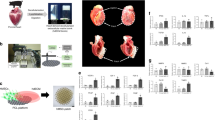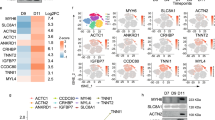Abstract
The use of stem cells to generate replacement cells for damaged heart muscle, valves, vessels and conduction cells holds great potential. Recent identification of multipotent progenitor cells in the heart and improved understanding of developmental processes relevant to pluripotent embryonic stem cells may facilitate the generation of specific types of cell that can be used to treat human heart disease. Secreted factors from circulating progenitor cells that localize to sites of damage may also be useful for tissue protection or neovascularization. The exciting discoveries in basic science will require rigorous testing in animal models to determine those most worthy of future clinical trials.
This is a preview of subscription content, access via your institution
Access options
Subscribe to this journal
Receive 51 print issues and online access
$199.00 per year
only $3.90 per issue
Buy this article
- Purchase on Springer Link
- Instant access to full article PDF
Prices may be subject to local taxes which are calculated during checkout


Similar content being viewed by others
References
American Heart Association in Heart Disease and Stroke Statistics—2004 Update 11–14 (American Heart Association, Dallas, Texas, 2004).
Oh, H. et al. Cardiac progenitor cells from adult myocardium: homing, differentiation, and fusion after infarction. Proc. Natl Acad. Sci. USA 100, 12313–12318 (2003).
Beltrami A. P. et al. Adult cardiac stem cells are multipotent and support myocardial regeneration. Cell 114, 763–776 (2003).
Martin, C. M. et al. Persistent expression of the ATP-binding cassette transporter, Abcg2, identifies cardiac SP cells in the developing and adult heart. Dev. Biol. 265, 262–275 (2004).
Shim, W. S. et al. Ex vivo differentiation of human adult bone marrow stem cells into cardiomyocyte-like cells. Biochem. Biophys. Res. Commun. 324, 481–488 (2004).
Urbanek, K. et al. Cardiac stem cells possess growth factor-receptor systems that after activation regenerate the infarcted myocardium, improving ventricular function and long-term survival. Circ. Res. 97, 663–673 (2005).
Boiani, M. & Scholer, H. R. Regulatory networks in embryo-derived pluripotent stem cells. Nature Rev. Mol. Cell Biol. 6, 872–884 (2005).
Kitajima, S., Takagi, A., Inoue, T. & Saga, Y. MesP1 and MesP2 are essential for the development of cardiac mesoderm. Development 127, 3215–3226 (2000).
Wilson, V. & Beddington, R. Expression of T protein in the primitive streak is necessary and sufficient for posterior mesoderm movement and somite differentiation. Dev. Biol. 192, 45–58 (1997).
Buckingham, M., Meilhac, S. & Zaffran, S. Building the mammalian heart from two sources of myocardial cells. Nature Rev. Genet. 6, 826–835 (2005).
Cai, C. L. et al. Isl1 identifies a cardiac progenitor population that proliferates prior to differentiation and contributes a majority of cells to the heart. Dev. Cell 5, 877–889 (2003).
Laugwitz, K. L. et al. Postnatal isl1+ cardioblasts enter fully differentiated cardiomyocyte lineages. Nature 433, 647–653 (2005).
Sachinidis, A. et al. Cardiac specific differentiation of mouse embryonic stem cells. Cardiovasc. Res. 58, 278–291 (2003).
Pal, R. & Khanna, A. Role of Smad- and Wnt-dependent pathways in embryonic cardiac development. Stem Cells Dev. 15, 29–39 (2006).
Zhao, Y., Samal, E. & Srivastava, D. Serum response factor regulates a muscle-specific microRNA that targets Hand2 during cardiogenesis. Nature 436, 214–220 (2005).
Kwon, C., Han, Z., Olson, E. N. & Srivastava, D. MicroRNA1 influences cardiac differentiation in Drosophila and regulates Notch signaling. Proc. Natl Acad. Sci. USA 102, 18986–18991 (2005).
Ding, S. & Schultz, P. G. A role for chemistry in stem cell biology. Nature Biotechnol. 22, 833–840 (2004).
Laflamme, M. A. & Murry, C. E. Regenerating the heart. Nature Biotechnol. 23, 845–856 (2005).
Orlic, D. et al. Bone marrow cells regenerate infarcted myocardium. Nature 410, 701–705 (2001).
Murry, C. E. et al. Haematopoietic stem cells do not transdifferentiate into cardiac myocytes in myocardial infarcts. Nature 428, 664–668 (2004).
Balsam, L. B. et al. Haematopoietic stem cells adopt mature haematopoietic fates in ischaemic myocardium. Nature 428, 668–673 (2004).
Nygren, J. M. et al. Bone marrow-derived hematopoietic cells generate cardiomyocytes at a low frequency through cell fusion, but not transdifferentiation. Nature Med. 10, 494–501 (2004).
Mangi, A. A. et al. Mesenchymal stem cells modified with Akt prevent remodeling and restore performance of infarcted hearts. Nature Med. 9, 1195–1201 (2003).
Leri, A., Kajstura, J. & Anversa, P. Cardiac stem cells and mechanisms of myocardial regeneration. Physiol. Rev. 85, 1373–1416 (2005).
Janssens, S. et al. Autologous bone marrow-derived stem-cell transfer in patients with ST-segment elevation myocardial infarction: double-blind, randomised controlled trial. Lancet 367, 113–121 (2006).
Orlic, D. et al. Mobilized bone marrow cells repair the infarcted heart, improving function and survival. Proc. Natl Acad. Sci. USA 98, 10344–10349 (2001).
Zohlnhofer, D. et al. Stem cell mobilization by granulocyte colony-stimulating factor in patients with acute myocardial infarction: a randomized controlled trial. J. Am. Med. Assoc. 295, 1003–1010 (2006).
Gnecchi, M. et al. Evidence supporting paracrine hypothesis for Akt-modified mesenchymal stem cell-mediated cardiac protection and functional improvement. FASEB J. 20, 661–669 (2006).
Silva, W. A. Jr et al. The profile of gene expression of human marrow mesenchymal stem cells. Stem Cells 21, 661–669 (2003).
Bock-Marquette, I., Saxena, A., White, M. D., Dimaio, J. M. & Srivastava, D. Thymosin β4 activates integrin-linked kinase and promotes cardiac cell migration, survival and cardiac repair. Nature 432, 466–472 (2004).
Grant, D. S. et al. Thymosin β4 enhances endothelial cell differentiation and angiogenesis. Angiogenesis 3, 125–135 (1999).
Malinda, K. M., Goldstein, A. L. & Kleinman, H. K. Thymosin β4 stimulates directional migration of human umbilical vein endothelial cells. FASEB J. 11, 474–481 (1997).
Menasche, P. et al. Autologous skeletal myoblast transplantation for severe postinfarction left ventricular dysfunction. J. Am. Coll. Cardiol. 41, 1078–1083 (2003).
Brambrink, T., Hochedlinger, K., Bell, G. & Jaenisch, R. ES cells derived from cloned and fertilized blastocysts are transcriptionally and functionally indistinguishable. Proc. Natl Acad. Sci. USA 103, 933–938 (2006).
Cowan, C. A., Atienza, J., Melton, D. A. & Eggan, K. Nuclear reprogramming of somatic cells after fusion with human embryonic stem cell. Science 309, 1369–1373 (2005).
Acknowledgements
We thank K. Cordes for help in conceiving and generating the graphics. K.I. is a scholar of the California Institute of Regenerative Medicine. D.S. is supported by grants from the National Heart, Lung and Blood Institute, the National Institutes of Health and the March of Dimes Birth Defects Foundation, and is an Established Investigator of the American Heart Association.
Author information
Authors and Affiliations
Corresponding author
Ethics declarations
Competing interests
The authors declare no competing financial interests.
Additional information
Author Information Reprints and permissions information is available at npg.nature.com/reprintsandpermissions.
Rights and permissions
About this article
Cite this article
Srivastava, D., Ivey, K. Potential of stem-cell-based therapies for heart disease. Nature 441, 1097–1099 (2006). https://doi.org/10.1038/nature04961
Published:
Issue Date:
DOI: https://doi.org/10.1038/nature04961
This article is cited by
-
Cardiovascular Exosomes and MicroRNAs in Cardiovascular Physiology and Pathophysiology
Journal of Cardiovascular Translational Research (2021)
-
Argentatin B derivatives induce cell cycle arrest and DNA damage in human colon cancer cells through p73/p53 regulation
Medicinal Chemistry Research (2018)
-
Conditioned medium enhances the fusion capability of rat bone marrow mesenchymal stem cells and cardiomyocytes
Molecular Biology Reports (2014)
-
In vivo reprogramming of murine cardiac fibroblasts into induced cardiomyocytes
Nature (2012)
-
Autophagy and Heart Failure: A Possible Role for Homocysteine
Cell Biochemistry and Biophysics (2012)
Comments
By submitting a comment you agree to abide by our Terms and Community Guidelines. If you find something abusive or that does not comply with our terms or guidelines please flag it as inappropriate.



